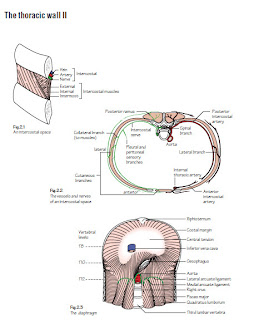The thoracic cage is formed by the sternum and costal cartilages in
front, the vertebral column behind and the ribs and intercostal spaces
laterally.
It is separated from the abdominal cavity by the diaphragm and communicates
superiorly with the root of the neck through the
thoracic
inlet
(Fig. 1.1).
The ribs
(Fig. 1.1)
• Of the 12 pairs of ribs the first seven articulate with the vertebrae posteriorly
and with the sternum anteriorly by way of the costal cartilages
(
true ribs).
• The cartilages of the 8th, 9th and 10th ribs articulate with the cartilages
of the ribs above (
false ribs).
• The 11th and 12th ribs are termed ‘floating’ because they do not articulate
anteriorly (
false ribs).
Typical ribs (3rd–9th)
These comprise the following features (Fig. 1.2):
• A
head which bears two demifacets for articulation with the bodies
of: the numerically corresponding vertebra, and the vertebra above
(Fig. 1.4).
• A
tubercle which comprises a rough non-articulating lateral facet as
well as a smooth medial facet. The latter articulates with the transverse
process of the corresponding vertebra (Fig. 1.4).
• A
subcostal groove: the hollow on the inferior inner aspect of the
shaft which accommodates the intercostal neurovascular structures.
Atypical ribs (1st, 2nd, 10th, 11th, 12th)
• The
1st rib (see Fig. 63.2) is short, flat and sharply curved. The head
bears a single facet for articulation. A prominent tubercle (
scalene
tubercle
) on the inner border of the upper surface represents the insertion
site for scalenus anterior. The subclavian vein passes over the 1st
rib anterior to this tubercle whereas the subclavian artery and lowest
trunk of the brachial plexus pass posteriorly.
A cervical rib is a rare ‘extra’ rib which articulates with C7 posteriorly
and the 1st rib anteriorly. A neurological deficit as well as vascular
insufficiency arise as a result of pressure from the rib on the lowest
trunk of the brachial plexus (T1) and subclavian artery, respectively
(Fig. 1.3).
• The
2nd rib is less curved and longer than the 1st rib.
• The
10th rib has only one articular facet on the head.
• The
11th and 12th ribs are short and do not articulate anteriorly.
They articulate posteriorly with the vertebrae by way of a single facet
on the head. They are devoid of both a tubercle and a subcostal groove.
The sternum
(Fig. 1.1)
The sternum comprises a manubrium, body and xiphoid process.
• The
manubrium has facets for articulation with the clavicles, 1st
costal cartilage and upper part of the 2nd costal cartilage. It articulates
inferiorly with the body of the sternum at the
manubriosternal joint.
• The
body is composed of four parts or sternebrae which fuse between
15 and 25 years of age. It has facets for articulation with the lower part
of the 2nd and the 3rd to 7th costal cartilages.
• The
xiphoid articulates above with the body at the xiphisternal joint.
The xiphoid usually remains cartilaginous well into adult life.
Costal cartilages
These are bars of hyaline cartilage which connect the upper seven ribs
directly to the sternum and the 8th, 9th and 10th ribs to the cartilage
immediately above.
Joints of the thoracic cage
(Figs 1.1 and 1.4)
• The
manubriosternal joint is a symphysis. It usually ossifies after the
age of 30.
• The
xiphisternal joint is also a symphysis.
• The
1st sternocostal joint is a primary cartilaginous joint. The rest
(2nd to 7th) are synovial joints. All have a single synovial joint except
for the 2nd which is double.
• The
costochondral joints (between ribs and costal cartilages) are primary
cartilaginous joints.
• The
interchondral joints (between the costal cartilages of the 8th, 9th
and 10th ribs) are synovial joints.
• The
costovertebral joints comprise two synovial joints formed by the
articulations of the demifacets on the head of each rib with the bodies of
its corresponding vertebra together with that of the vertebra above. The
1st and 10th–12th ribs have a single synovial joint with their corresponding
vertebral bodies.
• The
costotransverse joints are synovial joints formed by the articulations
between the facets on the rib tubercle and the transverse process
of its corresponding vertebra
.








+Dementia+1.jpg)




0 التعليقات:
Post a Comment